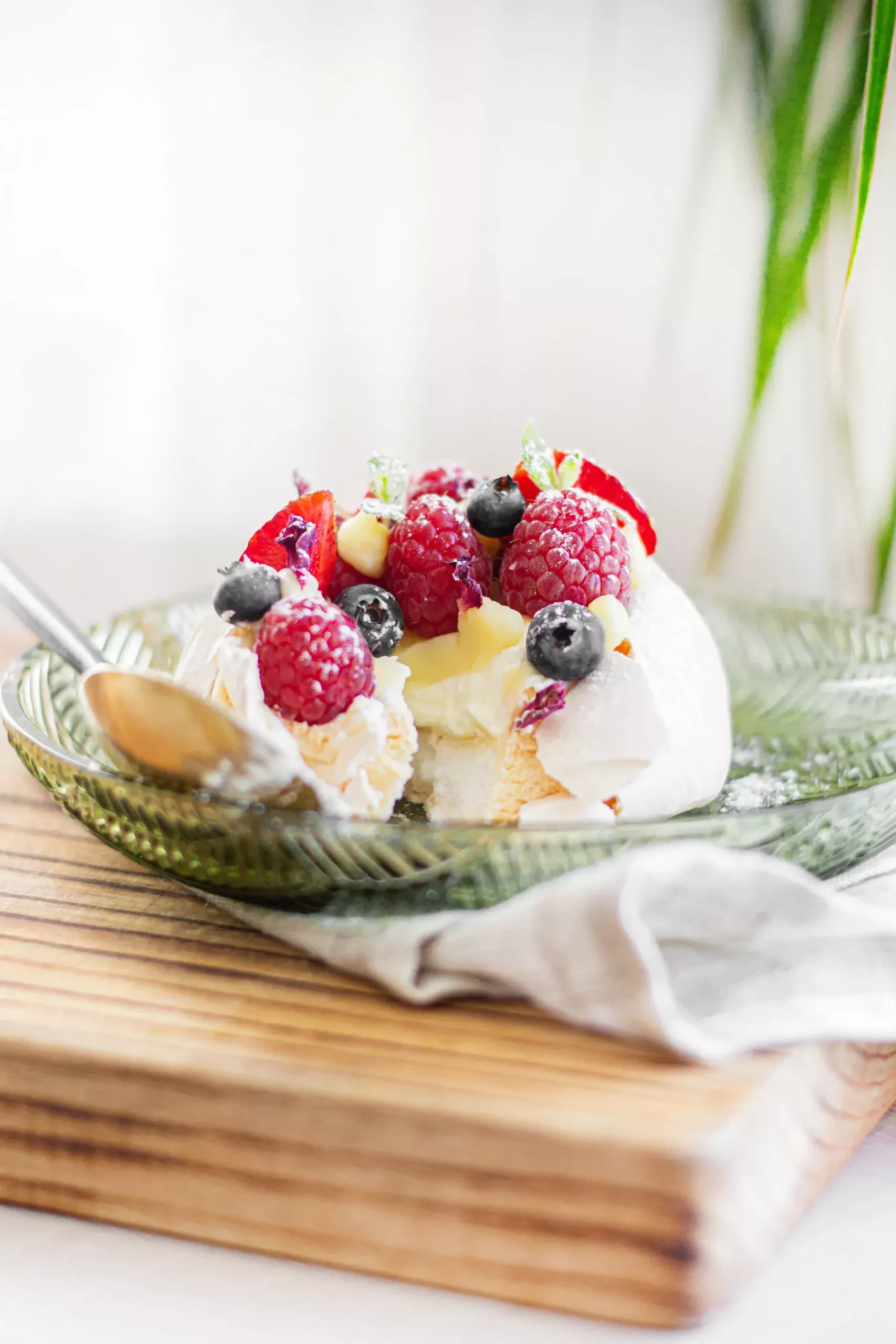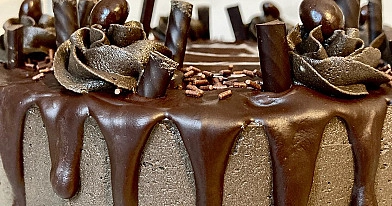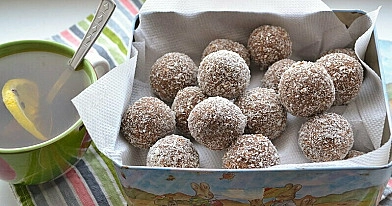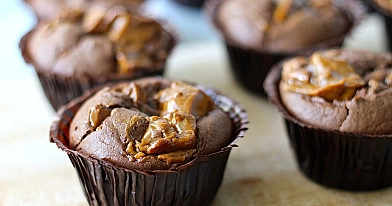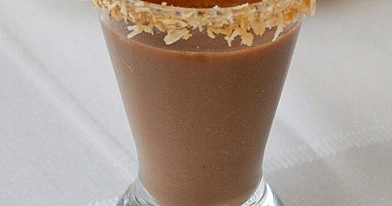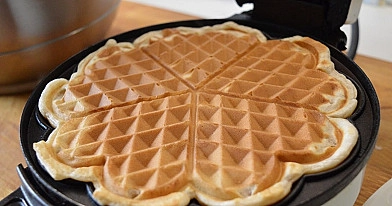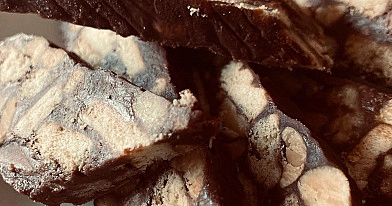
Mini pavlova recipe - pastries with mascarpone and lime cream
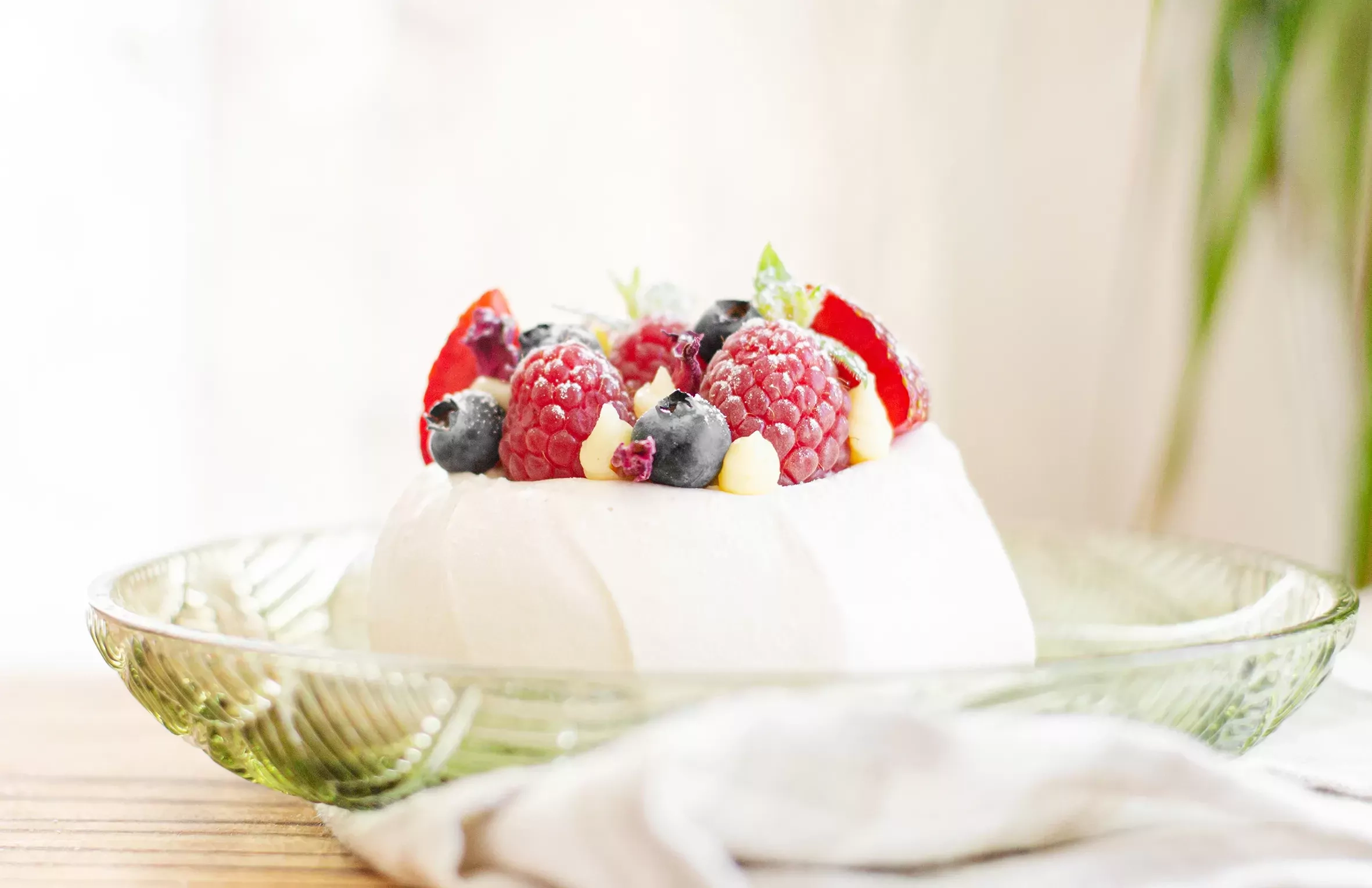
Pavlova is a moringa dessert that is rapidly gaining popularity worldwide. Our country is no exception: for several years now, more and more of our compatriots have been making this delicacy at home and flavouring it with seasonal berries. And what more is needed? Pavlova is a light and sweet treat that crowns summer moods with the most beautiful colours and flavours.
I must admit that until this summer there was no such thing as Pavlova in our house. And in cafés, my family and I used to frown and choose something different when we were choosing desserts with our coffee.
In the summer season, pavlova is what saves anyone who is tired of sponge cakes, with their richer and heavier flavours of chocolate, caramel or nuts.
A little history.
If you are already familiar with pavlova, you are probably well aware that this moringa cake is named after Anna Pavlova, the famous Russian ballerina, when she toured Australia and New Zealand. It is not surprising that Pavlova has become the national dessert of these two countries and is made not only during the summer, but also during festivities such as Christmas. The traditional cake is decorated with whipped cream and fruit and berries (usually strawberries, kiwis and passion fruit).
Pavlova is not an old dessert either. A cake recipe almost identical to the modern-day pavlova was first published in a cookbook by Australian Emily Futter in 1922. But whether she is the author of the dessert is not fully known.
It can also be pointed out that various food critics disagree that the pavlova cake is an authentic Australian and New Zealand creation. It is argued that since morengs have been known and made for a long time, pavlova is simply a different version of the moreng dessert. As it happens, this delicacy is made in a different way to the usual morengs, and this method of preparation makes the cake a much more fragile creation.
The pavlova also seems to be a pretty easy dessert to make. This can be partially accepted, as the moreng recipe itself is not really complicated or requiring many fancy ingredients. But the production process itself has a number of 'hooks' which are very easy to fall for. Moreng is not at all friendly with fat, so you may want to dry the dish thoroughly first and clean it with a paper towel soaked in vinegar or lemon juice.
- The egg whites must be at room temperature.
- It would be better to use the whites of an older egg rather than a fresher egg. This will make the pavlova moreng more rigid.
- Under no circumstances should the egg whites be whipped. Ideally, when you start whipping the moreng with an electric mixer, set the timer for 10 minutes. By the 8th minute, you must be slowly adding the sugar a spoonful at a time.
- Use the finest sugar possible, but not icing sugar. It is quite common abroad to use very fine caster sugar in desserts, but I have not been able to find it to buy it. Anyway, there is no need to be sad about it - you can use an electric chopper to crush regular sugar. Who needs this? The sugar must be dissolved in the Pavlova moreng. You can check whether the sugar is fully dissolved by rubbing a little of the moreng between your fingers. The large remaining sugar crystals can trap moisture and release it as the pavlova dries.
- The acid is always added after the sugar has been added to the egg whites.
- The starch is added carefully with a spatula and is not just added to the egg white and sugar mixture with a mixer. Ideally, after adding half of the sugar to the whisking egg whites, stop whisking, add the starch and continue adding the sugar and mixing. Both the starch and the acid act as stabilisers for the moreng. It is said that it is the starch that helps to keep the outside of the pavlova crisp and the inside soft, but there are as many claims as there are facts to contradict them. Anyway, starch does not really hurt.
- When shaping the pavlova, attach the baking paper to the baking tray with the moreng. Otherwise, I'm sure you'll have a hard time!
- There are all kinds of pavlovas - low, high, round, rectangular and so on, but remember that when you are shaping the moreng, you must think about decorating the pavlova with creams and berries. So make the surface of the moreng smooth or slightly concave. This way, all the fruity beauties stay in place and don't slip off.
- Moreng is a rather inhospitable thing and doesn't like humidity or sudden temperature fluctuations. So never open the oven! Bake the moreng and, once baked, simply leave it in the oven to cool completely. It is best to bake the moreng late in the evening, leave it in the oven overnight and decorate it in the morning, or bake it in the morning and decorate it in the evening. The undecorated pavlova can be kept in a tightly sealed container for several days. It is also generally agreed that pavlova needs good weather, as it is very difficult to dry the moreng in the rain and will have to wait for sunny days. What can I say? There is a lot of truth in that (at least in my personal experience).
- We are not afraid of cracks. A real pavlova does have them. We cover the cracks in the top with cream and berries, so you can't see them. Well, if the pavlova collapses when you try to put it on the plate, put the cream and berries on the plates with the pavlova crumbs and serve a deconstructed version of the dessert. This doesn't compromise the taste!
About the creams:
Mascarpone cream. Mascarpone cream is very simple to make. It can be prepared in just a few minutes. However, it is necessary not to whip the cream to the consistency of whipped cream. Let it be soft, fluffy and slightly runny. This cream will be like a counterbalance to the sweet moreng, as it is refreshing and quite neutral.
Lime cream. As moreng is sweet, mascarpone cream is neutral, so the lime cream is what gives it that extra zing. The cream, which goes perfectly with the berries, has a rich flavour but is very versatile and can be used in many ways - with biscuits, eclairs, etc.
Lime cream is a little more complicated to make than mascarpone, but it remains one of the easiest pastry creams I've ever tried to make. And sure, I have made creams that have taken a lot of effort to make, but the lime cream you are about to try was many times better. And it's definitely easier to make!
I've looked at the mistakes of making pavlova and their solutions. The pavlova recipe we have perfected has changed my family's life and our perception of summer dessert. We hope it will leave an impression on you too! You can try making one large pavlova (but it is advisable not to exceed 5 centimetres in height), or you can choose to make 8 small mini pavlovas and enjoy individual desserts (as I always do). And now for the recipe!
I must admit that until this summer there was no such thing as Pavlova in our house. And in cafés, my family and I used to frown and choose something different when we were choosing desserts with our coffee.
In the summer season, pavlova is what saves anyone who is tired of sponge cakes, with their richer and heavier flavours of chocolate, caramel or nuts.
A little history.
If you are already familiar with pavlova, you are probably well aware that this moringa cake is named after Anna Pavlova, the famous Russian ballerina, when she toured Australia and New Zealand. It is not surprising that Pavlova has become the national dessert of these two countries and is made not only during the summer, but also during festivities such as Christmas. The traditional cake is decorated with whipped cream and fruit and berries (usually strawberries, kiwis and passion fruit).
Pavlova is not an old dessert either. A cake recipe almost identical to the modern-day pavlova was first published in a cookbook by Australian Emily Futter in 1922. But whether she is the author of the dessert is not fully known.
It can also be pointed out that various food critics disagree that the pavlova cake is an authentic Australian and New Zealand creation. It is argued that since morengs have been known and made for a long time, pavlova is simply a different version of the moreng dessert. As it happens, this delicacy is made in a different way to the usual morengs, and this method of preparation makes the cake a much more fragile creation.
Advertisement
The pavlova also seems to be a pretty easy dessert to make. This can be partially accepted, as the moreng recipe itself is not really complicated or requiring many fancy ingredients. But the production process itself has a number of 'hooks' which are very easy to fall for. Moreng is not at all friendly with fat, so you may want to dry the dish thoroughly first and clean it with a paper towel soaked in vinegar or lemon juice.
- The egg whites must be at room temperature.
- It would be better to use the whites of an older egg rather than a fresher egg. This will make the pavlova moreng more rigid.
- Under no circumstances should the egg whites be whipped. Ideally, when you start whipping the moreng with an electric mixer, set the timer for 10 minutes. By the 8th minute, you must be slowly adding the sugar a spoonful at a time.
- Use the finest sugar possible, but not icing sugar. It is quite common abroad to use very fine caster sugar in desserts, but I have not been able to find it to buy it. Anyway, there is no need to be sad about it - you can use an electric chopper to crush regular sugar. Who needs this? The sugar must be dissolved in the Pavlova moreng. You can check whether the sugar is fully dissolved by rubbing a little of the moreng between your fingers. The large remaining sugar crystals can trap moisture and release it as the pavlova dries.
- The acid is always added after the sugar has been added to the egg whites.
- The starch is added carefully with a spatula and is not just added to the egg white and sugar mixture with a mixer. Ideally, after adding half of the sugar to the whisking egg whites, stop whisking, add the starch and continue adding the sugar and mixing. Both the starch and the acid act as stabilisers for the moreng. It is said that it is the starch that helps to keep the outside of the pavlova crisp and the inside soft, but there are as many claims as there are facts to contradict them. Anyway, starch does not really hurt.
- When shaping the pavlova, attach the baking paper to the baking tray with the moreng. Otherwise, I'm sure you'll have a hard time!
- There are all kinds of pavlovas - low, high, round, rectangular and so on, but remember that when you are shaping the moreng, you must think about decorating the pavlova with creams and berries. So make the surface of the moreng smooth or slightly concave. This way, all the fruity beauties stay in place and don't slip off.
- Moreng is a rather inhospitable thing and doesn't like humidity or sudden temperature fluctuations. So never open the oven! Bake the moreng and, once baked, simply leave it in the oven to cool completely. It is best to bake the moreng late in the evening, leave it in the oven overnight and decorate it in the morning, or bake it in the morning and decorate it in the evening. The undecorated pavlova can be kept in a tightly sealed container for several days. It is also generally agreed that pavlova needs good weather, as it is very difficult to dry the moreng in the rain and will have to wait for sunny days. What can I say? There is a lot of truth in that (at least in my personal experience).
- We are not afraid of cracks. A real pavlova does have them. We cover the cracks in the top with cream and berries, so you can't see them. Well, if the pavlova collapses when you try to put it on the plate, put the cream and berries on the plates with the pavlova crumbs and serve a deconstructed version of the dessert. This doesn't compromise the taste!
About the creams:
Mascarpone cream. Mascarpone cream is very simple to make. It can be prepared in just a few minutes. However, it is necessary not to whip the cream to the consistency of whipped cream. Let it be soft, fluffy and slightly runny. This cream will be like a counterbalance to the sweet moreng, as it is refreshing and quite neutral.
Lime cream. As moreng is sweet, mascarpone cream is neutral, so the lime cream is what gives it that extra zing. The cream, which goes perfectly with the berries, has a rich flavour but is very versatile and can be used in many ways - with biscuits, eclairs, etc.
Advertisement
Lime cream is a little more complicated to make than mascarpone, but it remains one of the easiest pastry creams I've ever tried to make. And sure, I have made creams that have taken a lot of effort to make, but the lime cream you are about to try was many times better. And it's definitely easier to make!
Advertisement
I've looked at the mistakes of making pavlova and their solutions. The pavlova recipe we have perfected has changed my family's life and our perception of summer dessert. We hope it will leave an impression on you too! You can try making one large pavlova (but it is advisable not to exceed 5 centimetres in height), or you can choose to make 8 small mini pavlovas and enjoy individual desserts (as I always do). And now for the recipe!
Ingredients
- Egg whites: 4 medium
- sugar: 225 grams
- wine stone powder: 0,5 teaspoon (or a teaspoon of vinegar or lemon juice)
- cornstarch: 1,5 teaspoon
- salt: pinch
- vanilla extract: 1 teaspoon
- lime zest: from 3 pieces.
- 70 grams of lime juice (from ~2 lemons)
- Eggs: 100 grams (~2 medium eggs)
- sugar: 110 grams
- butter: 150 grams
- salt: pinch
- Mascarpone: 120 grams
- 36% fat cream: 200 grams
- icing sugar: 40 grams
- Seasonal berries
- Peppermint leaves
- icing sugar
Pavlov:
For the lime cream:
For the mascarpone cream:
For decoration:
- 1. Pavlova: For the preparation of the pavlova, you will need sugar as fine as possible, but not icing sugar. It is recommended to put the normal sugar in an electric chopper and grind it in a pulsating motion.
- 2. Put the egg whites in a clean large bowl. Beat them with an electric mixer on high speed until well foamed.
- 3. Slowly add a tablespoon of sugar to the beaten egg whites (without further mixing). When half of the sugar has been added, switch off the mixer and gently fold in the cornstarch with a spatula. Once you have done this, turn the mixer back on and stop slowly adding the sugar.
- 4. After the sugar, add the acid - rock wine powder or a teaspoon of apple cider vinegar / lemon juice. Continue stirring for a few minutes until the moringa is stiff and glossy and the sugar has dissolved. You can check by rubbing a little of the mixture between your fingers.
- 5. But remember - don't overcook the proteins, or you'll end up with a big pancake.
- 6. On the baking paper, use a marker to draw a circle of the desired size (if you are baking one large pavlova) or 8 small circles (if you are baking several small pavlovas).
- 7. Flip the paper over to prevent the food from coming into contact with the ink and "glue" it to the tin with small pieces of meringue.
- 8. Glue it well so that you can really see the circles and the paper is stuck.
- 9. Place the moreng mass on the overlapping circles. It is very important to take your time and shape the top of the pavlova either smooth or concave, so that the berries and creams stick to the baked cake.
- 10. Preheat the oven to 150 degrees.
- 11. Once the pavlova is in the oven, reduce the temperature to 125 degrees and bake for up to 1 hour 15 minutes. The baking time may vary, but it is very important not to open the oven to prevent the moreng from cracking and falling apart.
- 12. Once the pavlova is baked, turn off the oven and leave the moringa to cool completely overnight or at least for a few hours.
- 13. Spoon mascarpone cream over the cooled moringa and drizzle some lime cream on top (this is the option I went for, so I'll show you how to make these creams below). Arrange the berries or fruit you want, with the lime cream in between. Garnish with mint leaves and a light dusting of icing sugar.
- 14. Lime cream: Pour the sugar into a saucepan and add the lime zest. Use your fingers to rub them well into the sugar.
- 15. Add the eggs and whisk well.
- 16. Then pour in the lime juice and a pinch of salt. Stir.
- 17. Place the saucepan on the hob and heat over a medium heat, stirring constantly, until the mixture reaches 83 degrees and thickens. As soon as this happens, remove the pot from the heat.
- 18. Strain the cream through a metal sieve into another clean bowl. Allow the cream mixture to cool to 60 degrees for a few minutes.
- 19. Then add the room temperature butter. Stir until the butter is completely melted and you have a glossy, smooth cream.
- 20. Cool the cream, put it in a pastry bag and use it to decorate the pavlova. Refrigerate.
- 21. Mascarpone cream: Beat the mascarpone cheese at room temperature with the icing sugar using an electric mixer.
- 22. Pour the cream into the bowl with the mascarpone. Stir until a fluffy cream forms. Do not overmix!
- 23. Refrigerate the cream before serving.
- 24. Once baked, the pavlova can be decorated immediately, or kept in a tightly sealed container for several days. However, if the moreng gets any moisture, it will lose its crispness. Enjoy!
Recipe Directions
